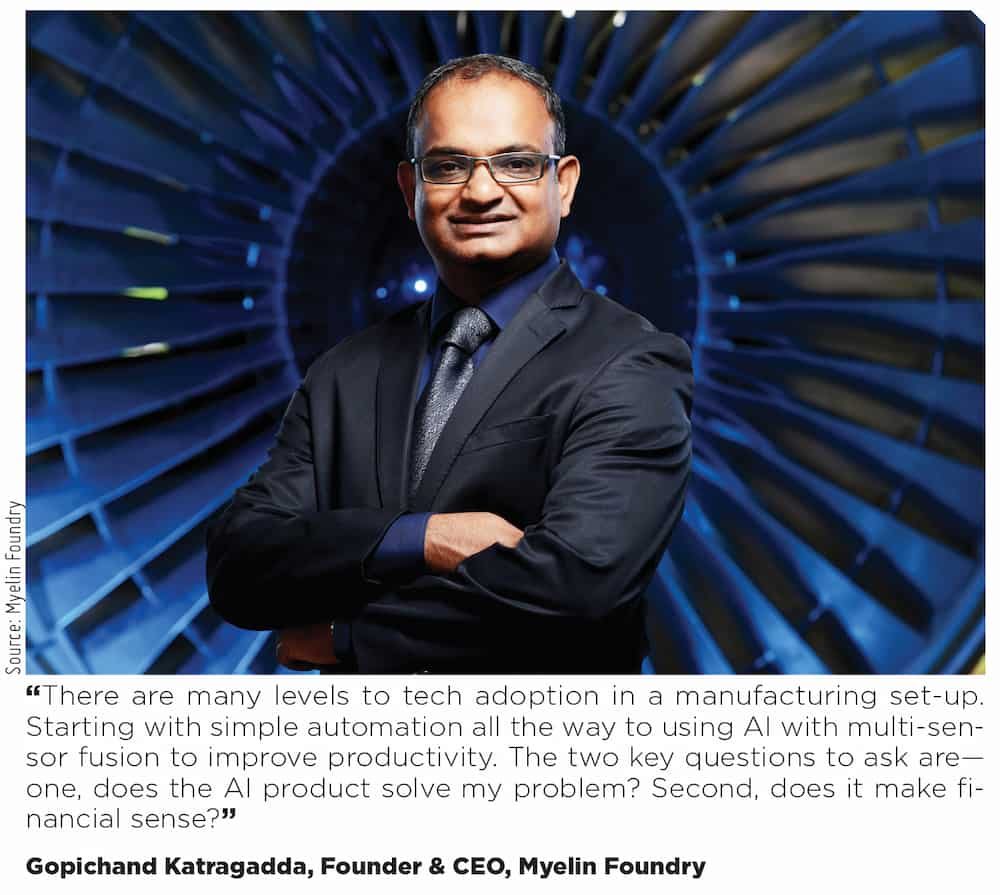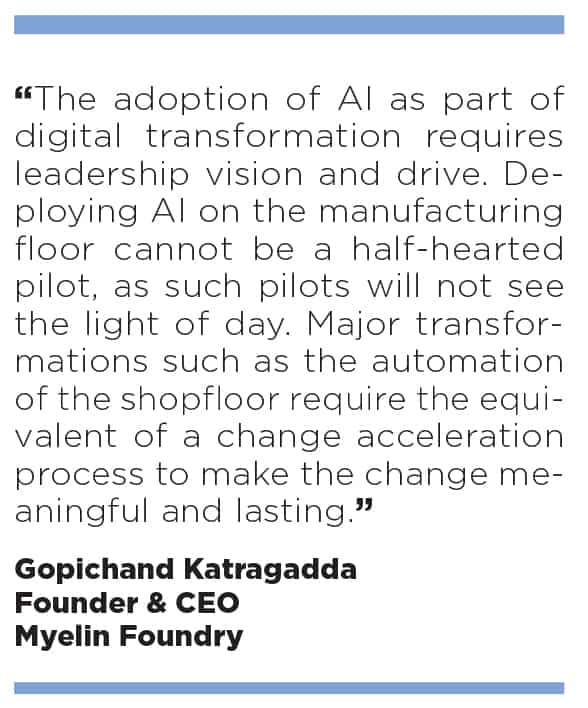CHANGING THE GAME

Gopichand Katragadda, Founder & CEO, Myelin Foundry, shares with MMI’s Editor-in-Chief Soumi Mitra the thought behind the intriguing ‘Foundry’ in the company’s name and his views on Indian manufacturing players’ standing in terms of investing in AI and how this is the time for India to take the lead in areas such as EDGE AI for manufacturing.
Your company is a factory of Artificial Intelligence (AI) products. It’s interesting that you have named it a foundry. Kindly tell us about Myelin Foundry and its solutions.
Gopichand Katragadda: Myelin Foundry was set up as a factory of innovative AI products. In terms of the name, Myelin is the protective covering of the neuron denoting AI and ‘foundry’ denotes a factory. Our products execute AI, closest to where the data is being generated or consumed. Examples include anomaly detection in manufacturing, enhancing user experiences on mobile for video streaming, and in-auto intelligence based on video and audio. The critical innovations are around real-time AI inferencing on low-compute at low-power overheads.
The impact of AI in manufacturing is game-changing. It automates complex tasks and comes up with new manufacturing processes. How far have the Indian manufacturing players come in terms of investing in it to boost the efficiency and productivity of their production plants?
Katragadda: There are many levels to tech adoption in a manufacturing set-up. Starting with simple automation all the way to using AI with multi-sensor fusion to improve productivity. The two key questions to ask are—one, does the AI product solve my problem? Second, does it make financial sense?
Most AI solutions in manufacturing set-ups are a demonstrator, if not constrained to a specific point on the shopfloor. This is because unleashing the potential of AI needs the solution to run in real-time or near real-time, providing results in sync with the takt time of the manufacturing line. This needs powerful EDGE to compute without live-cloud connectivity or a 5G network with cloud connectivity. This has been a limiting factor in the widespread adoption of AI solutions.
At Myelin, we have cracked the two problems of running AI in resource-constrained environments on the EDGE in near-real time and addressed the issue of affordability. I believe that it is only a matter of time, i.e., the advent of a way to run AI in real-time on the EDGE and 5G before AI solutions become commonplace in mainstream manufacturing.
How much of a catalyst has the impact of the pandemic been for the manufacturing units that struggled with labor shortages to adopt AI-based solutions for continuing their production?
Katragadda: Operations involving simple visual inspection such as counting, checking for labels, and correctness of assembly, are areas where machine intelligence can directly substitute human intelligence. We are seeing traction in adopting AI for performing tasks of a repetitive nature and freeing up limited manpower to carry on other complex and decision-intensive tasks up the value chain.
Having said this, with the increased adoption rates of AI in the industries, new and interesting career paths are opening, such as those of data scientists, machine learning operators, and so on.
However, a complex visual inspection that involves assessing data in real-time has not taken off in a big way today due to the limitations in the adoption of EDGE AI computing.

Global players are shifting their manufacturing bases from China to India. Are Indian players seizing this opportunity and leveraging AI to provide them with a conducive and interactive environment?
Katragadda: We have a long way to go in India to become competitive in manufacturing. Most of our expensive core manufacturing equipment is imported. Labor arbitrage is disappearing with automation. This is the time for India to take the lead in areas such as EDGE AI for manufacturing.
How helpful have been Indian Government’s Aatmanirbhar Bharat and PLI schemes in the adoption of AI in the manufacturing industry?
Katragadda: The Government programs are great starting points. India also needs to look at the costs of energy,
ultra-clean water, and import duties on critical manufacturing equipment to continue down the path of self-sufficiency. The adoption of AI in manufacturing will improve productivity and self-sufficiency, but it is still a journey for the Indian industry.
Limited skills, expertise, and know-how around AI present barriers to organizations exploring its adoption. Please share your thoughts on the challenges in deploying AI in the Indian manufacturing sector and how those can be overcome.
 Katragadda: Organizations such as Bosch have done well in driving digital transformation through the organization. Successful digital transformation starts with workforce reskilling. Bespoke training programs are required for each level of the organization. The adoption of AI as part of digital transformation requires leadership vision and drive. Deploying AI on the manufacturing floor cannot be a half-hearted pilot, as such pilots will not see the light of day. Major transformations such as automation of the shopfloor require the equivalent of a change acceleration process to make the change meaningful and lasting.
Katragadda: Organizations such as Bosch have done well in driving digital transformation through the organization. Successful digital transformation starts with workforce reskilling. Bespoke training programs are required for each level of the organization. The adoption of AI as part of digital transformation requires leadership vision and drive. Deploying AI on the manufacturing floor cannot be a half-hearted pilot, as such pilots will not see the light of day. Major transformations such as automation of the shopfloor require the equivalent of a change acceleration process to make the change meaningful and lasting.
What are the key industries where you see major AI adoption in the near future?
Katragadda: Consumers have been early to accept AI in maps, social networking sites, and personal photo drives. Industries, where face recognition, gesture mapping, object detection, and anomaly detection provide significant value, will be the first to adopt AI in business. Additionally, industries will demand demonstrable returns for inserting AI and must be able to afford the intervention. The industries that meet the criteria for first adopting AI include national security, surveillance, automotive, steel manufacturing, non-destructive testing, chemical manufacturing, textile manufacturing, and food production.
How do you look at the potential of the Indian Manufacturing sector to become a global manufacturing hub and reach US$1 trillion by 2025?
Katragadda: Rather than 2025, I would suggest the following for India to reach its potential in manufacturing by 2030:
- Double power generation capacity (to 800 GW) last mile, smart measurements, and inclusion;
- Double transportation road miles per capita and air miles per capita;
- Government and industry partner to double R&D investment to 2 percent of GDP;
- Fund equipment at all primary and secondary care centers for women, infants, and elderly care. Total HC spending in India can increase from 3.6 percent of GDP to 5 percent of GDP. Which more than doubles the absolute spend with the growing GDP; and
- Train 500 million workers to contribute hands-on to power generation, water treatment, and healthcare.

SOUMI MITRA
Editor-in-Chief
Modern Manufacturing India
soumi.mitra@magicwandmedia.in




 Facebook
Facebook.png) Twitter
Twitter Linkedin
Linkedin Subscribe
Subscribe